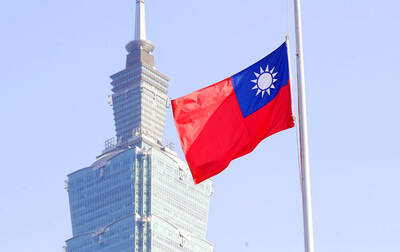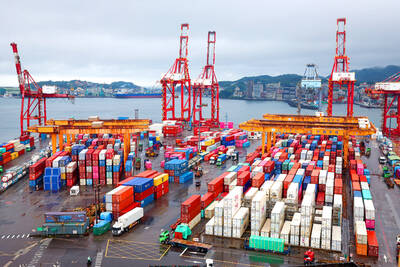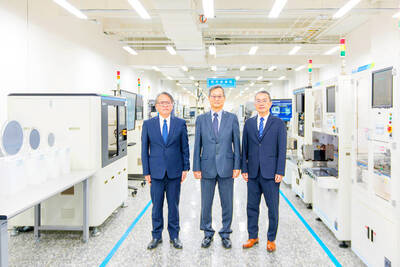The New Taiwan dollar rose 0.45 percent yesterday, surging past the NT$33 mark against the US currency, as investors poured more funds into the local bourse in hopes of taking profits from improving cross-strait trade, analysts said.
The local currency gained NT$0.151 to close at NT$32.889 against the greenback, its strongest level this year, Taipei Forex Inc data showed.
Jack Huang (黃蔭基), head of research at SinoPac Financial Holdings Co (永豐金控), attributed the NT dollar’s rise to a continued influx of hot money and capital repatriation after the government cut the inheritance tax to a flat 10 percent, from a range of 2 percent to 50 percent.
The benchmark TAIEX rose 63.63 points to close at 6,647.5 on turnover of NT$189.61 billion (US$5.8 billion) after rallying 9.9 percent last week, Taiwan Stock Exchange tallies showed.
Huang said the NT dollar could strengthen further this year on the back of the expected sequential quarterly improvement in economic fundamentals, while demand for the US dollar could weaken because of the US Federal Reserve’s quantitative easing policy.
“Except for the jobless rate, major economic indicators have shown improvements,” Huang said by telephone. “The situation will turn even better in the second half.”
SinoPac Financial forecast that the NT dollar would trade at an average of NT$33.2 versus its US counterpart this year. On a quarterly basis, the local currency is expected to strengthen from an average of NT$33.9 in the first quarter to NT$33.5 in the second quarter, NT$33 in the third quarter and NT$32.5 in the fourth quarter.
Huang said the central bank was unlikely to allow the NT dollar to climb over the NT$32.3 level, saying the monetary regulator’s tolerance for fluctuation was limited to NT$3 a year at the most. The NT dollar dipped to a low of NT$35.3 in February. The local currency opened yesterday at NT$33.04 and traded between NT$32.821 and NT$33.04 during the day.
A dealer at a local bank agreed that capital inflows contributed to the NT dollar’s appreciation.
But the dealer, who requested anonymity, said he believed the central bank would halt the rally once the NT dollar reaches the NT$32.6 mark against the greenback.
“Exporters are bound to complain if the [NT dollar’s] rally continues unchecked,” the trader said by telephone. “The central bank is well aware of the importance of exports on the economy.”

ELECTRONICS BOOST: A predicted surge in exports would likely be driven by ICT products, exports of which have soared 84.7 percent from a year earlier, DBS said DBS Bank Ltd (星展銀行) yesterday raised its GDP growth forecast for Taiwan this year to 4 percent from 3 percent, citing robust demand for artificial intelligence (AI)-related exports and accelerated shipment activity, which are expected to offset potential headwinds from US tariffs. “Our GDP growth forecast for 2025 is revised up to 4 percent from 3 percent to reflect front-loaded exports and strong AI demand,” Singapore-based DBS senior economist Ma Tieying (馬鐵英) said in an online briefing. Taiwan’s second-quarter performance beat expectations, with GDP growth likely surpassing 5 percent, driven by a 34.1 percent year-on-year increase in exports, Ma said, citing government

‘REMARKABLE SHOWING’: The economy likely grew 5 percent in the first half of the year, although it would likely taper off significantly, TIER economist Gordon Sun said The Taiwan Institute of Economic Research (TIER) yesterday raised Taiwan’s GDP growth forecast for this year to 3.02 percent, citing robust export-driven expansion in the first half that is likely to give way to a notable slowdown later in the year as the front-loading of global shipments fades. The revised projection marks an upward adjustment of 0.11 percentage points from April’s estimate, driven by a surge in exports and corporate inventory buildup ahead of possible US tariff hikes, TIER economist Gordon Sun (孫明德) told a news conference in Taipei. Taiwan’s economy likely grew more than 5 percent in the first six months

SMART MANUFACTURING: The company aims to have its production close to the market end, but attracting investment is still a challenge, the firm’s president said Delta Electronics Inc (台達電) yesterday said its long-term global production plan would stay unchanged amid geopolitical and tariff policy uncertainties, citing its diversified global deployment. With operations in Taiwan, Thailand, China, India, Europe and the US, Delta follows a “produce at the market end” strategy and bases its production on customer demand, with major site plans unchanged, Delta president Simon Chang (張訓海) said on the sidelines of a company event yesterday. Thailand would remain Delta’s second headquarters, as stated in its first-quarter earnings conference, with its plant there adopting a full smart manufacturing system, Chang said. Thailand is the firm’s second-largest overseas

SUPPLY RESILIENCE: The extra expense would be worth it, as the US firm is diversifying chip sourcing to avert disruptions similar to the one during the pandemic, the CEO said Advanced Micro Devices Inc (AMD) chief executive officer Lisa Su (蘇姿丰) on Wednesday said that the chips her company gets from supplier Taiwan Semiconductor Manufacturing Co (TSMC, 台積電) would cost more when they are produced in TSMC’s Arizona facilities. Compared with similar parts from factories in Taiwan, the US chips would be “more than 5 percent, but less than 20 percent” in terms of higher costs, she said at an artificial intelligence (AI) event in Washington. AMD expects its first chips from TSMC’s Arizona facilities by the end of the year, Su said. The extra expense is worth it, because the company is